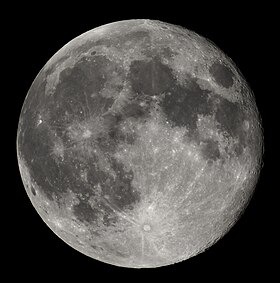
 The Moon is Earth's only natural satellite and the fifth largest satellite in the Solar System. The average centre-to-centre distance from the Earth to the Moon is 384,403 kilometres (238,857 mi), about thirty times the diameter of the Earth. The common centre of mass of the system (the barycentre) is located at about 1,700 kilometres (1,100 mi)—a quarter the Earth's radius—beneath the surface of the Earth. The Moon makes a complete orbit around the Earth every 27.3 (the orbital period), and the periodic variations in the geometry of the Earth–Moon–Sun system are responsible for the phases of the Moon, which repeat every 29.5 (the synodic period).
The Moon is Earth's only natural satellite and the fifth largest satellite in the Solar System. The average centre-to-centre distance from the Earth to the Moon is 384,403 kilometres (238,857 mi), about thirty times the diameter of the Earth. The common centre of mass of the system (the barycentre) is located at about 1,700 kilometres (1,100 mi)—a quarter the Earth's radius—beneath the surface of the Earth. The Moon makes a complete orbit around the Earth every 27.3 (the orbital period), and the periodic variations in the geometry of the Earth–Moon–Sun system are responsible for the phases of the Moon, which repeat every 29.5 (the synodic period).The Moon's diameter is 3,474 kilometres (2,159 mi), a little more than a quarter of Earth's. Thus, the Moon's surface area is less than a tenth of the Earth (about a quarter of Earth's land area), and its volume is about 2 percent that of Earth. The pull of gravity at its surface is about 17 percent of that at the Earth's surface.
The Moon is the only celestial body on which human beings have made a manned landing. While the Soviet Union's Luna programme was the first to reach the Moon with unmanned spacecraft, the United States' NASA Apollo program achieved the only manned missions to date, beginning with the first manned lunar mission by Apollo 8 in 1968, and six manned lunar landings between 1969 and 1972 – the first being Apollo 11 in 1969. Human exploration of the Moon temporarily ceased with the conclusion of the Apollo program, although a few robotic landers and orbiters have been sent to the Moon since that time. The U.S. had committed to return to the Moon by 2018, however that commitment has been put into jeopardy by the proposed 2011 budget, which will cancel Constellation, NASA's project to send humans back to the moon by 2020. On November 13, 2009, NASA announced the discovery of proof that water exists on the Moon, based on data obtained from its LCROSS lunar impact mission.
Surface geology
The Moon is in synchronous rotation, which means it rotates about its axis in about the same time it takes to orbit the Earth. This results in it nearly always keeping the same face turned towards the Earth. The Moon used to rotate at a faster rate, but early in its history, its rotation slowed and became locked in this orientation as a result of frictional effects associated with tidal deformations caused by the Earth. The side of the Moon that faces Earth is called the near side, and the opposite side the far side. The far side is often inaccurately called the "dark side," but in fact, it is illuminated exactly as often as the near side: once per lunar day, during the new Moon phase we observe on Earth when the near side is dark.The topography of the Moon has been measured with laser altimetry and stereo image analysis The most visible topographic feature is the giant far side South Pole-Aitken basin, some 2,240 km in diameter, the largest crater on the Moon and one of the largest known craters in the Solar System. At 13 km deep, its floor is the lowest elevation on the Moon. The highest elevations are found just to its north-east, and it has been suggested that this area might represent thick ejecta deposits that were emplaced during an oblique South Pole-Aitken basin impact event. Other large impact basins, such as Imbrium, Serenitatis, Crisium, Smythii, and Orientale, also possess regionally low elevations and elevated rims. The lunar far side is on average about 1.9 km higher than the
No comments:
Post a Comment